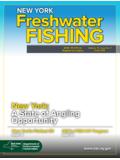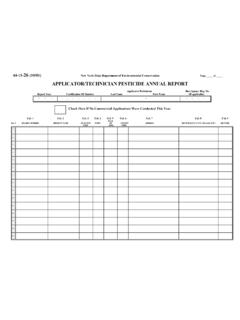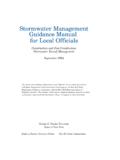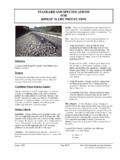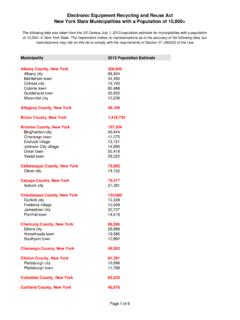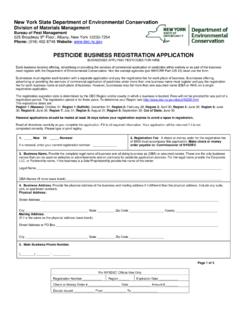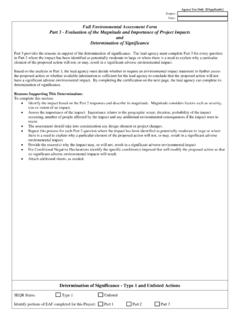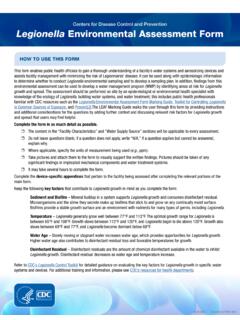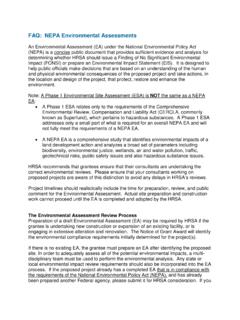Transcription of Full Environmental Assessment Form Part 2 - New York …
1 Page 1 of 10 full Environmental Assessment form Part 2 - Identification of Potential Project Impacts Part 2 is to be completed by the lead agency. Part 2 is designed to help the lead agency inventory all potential resources that could be affected by a proposed project or action. We recognize that the lead agency=s reviewer(s) will not necessarily be Environmental professionals. So, the questions are designed to walk a reviewer through the Assessment process by providing a series of questions that can be answered using the information found in Part 1. To further assist the lead agency in completing Part 2, the form identifies the most relevant questions in Part 1 that will provide the information needed to answer the Part 2 question. When Part 2 is completed, the lead agency will have identified the relevant Environmental areas that may be impacted by the proposed activity.
2 If the lead agency is a state agency and the action is in any Coastal Area, complete the Coastal Assessment form before proceeding with this Assessment . Tips for completing Part 2: Review all of the information provided in Part 1. Review any application, maps, supporting materials and the full EAF Workbook. Answer each of the 18 questions in Part 2. If you answer Yes to a numbered question, please complete all the questions that follow in that section. If you answer No to a numbered question, move on to the next numbered question. Check appropriate column to indicate the anticipated size of the impact. Proposed projects that would exceed a numeric threshold contained in a question should result in the reviewing agencychecking the box Moderate to large impact may occur. The reviewer is not expected to be an expert in Environmental analysis. If you are not sure or undecided about the size of an impact, it may help to review the sub-questions for the generalquestion and consult the workbook.
3 When answering a question consider all components of the proposed activity, that is, the Awhole Consider the possibility for long-term and cumulative impacts as well as direct impacts. Answer the question in a reasonable manner considering the scale and context of the on LandProposed action may involve construction on, or physical alteration of, NO YES the land surface of the proposed site. (See Part 1. )If Yes , answer questions a - j. If No , move on to Section Part I Question(s) No, or small impact may occur Moderate to large impact may occur a. The proposed action may involve construction on land where depth to water table isless than 3 99b. The proposed action may involve construction on slopes of 15% or 99c. The proposed action may involve construction on land where bedrock is exposed, orgenerally within 5 feet of existing ground 99d. The proposed action may involve the excavation and removal of more than 1,000 tonsof natural 99e.
4 The proposed action may involve construction that continues for more than one yearor in multiple 99f. The proposed action may result in increased erosion, whether from physicaldisturbance or vegetation removal (including from treatment by herbicides).D2e, D2q 99g. The proposed action is, or may be, located within a Coastal Erosion hazard 99h. Other impacts: _____ 99 Agency Use Only [If applicable]Project :Date :Page 2 of 10 2. Impact on Geological Features The proposed action may result in the modification or destruction of, or inhibit access to, any unique or unusual land forms on the site ( , cliffs, dunes, NO YES minerals, fossils, caves). (See Part 1. ) If Yes , answer questions a - c. If No , move on to Section 3. Relevant Part I Question(s) No, or small impact may occur Moderate to large impact may occur a. Identify the specific land form (s) attached: _____ _____ E2g 9 9 b.
5 The proposed action may affect or is adjacent to a geological feature listed as a registered National Natural Landmark. Specific feature: _____ E3c 9 9 c. Other impacts: _____ _____ 9 9 3. Impacts on Surface Water The proposed action may affect one or more wetlands or other surface water NO YES bodies ( , streams, rivers, ponds or lakes). (See Part 1. , ) If Yes , answer questions a - l. If No , move on to Section 4. Relevant Part I Question(s) No, or small impact may occur Moderate to large impact may occur a. The proposed action may create a new water body. D2b, D1h 9 9 b. The proposed action may result in an increase or decrease of over 10% or more than a 10 acre increase or decrease in the surface area of any body of water. D2b 9 9 c. The proposed action may involve dredging more than 100 cubic yards of material from a wetland or water body.
6 D2a 9 9 d. The proposed action may involve construction within or adjoining a freshwater or tidal wetland, or in the bed or banks of any other water body. E2h 9 9 e. The proposed action may create turbidity in a waterbody, either from upland erosion, runoff or by disturbing bottom sediments. D2a, D2h 9 9 f. The proposed action may include construction of one or more intake(s) for withdrawal of water from surface water. D2c 9 9 g. The proposed action may include construction of one or more outfall(s) for discharge of wastewater to surface water(s). D2d 9 9 h. The proposed action may cause soil erosion, or otherwise create a source of stormwater discharge that may lead to siltation or other degradation of receiving water bodies. D2e 9 9 i. The proposed action may affect the water quality of any water bodies within or downstream of the site of the proposed action.
7 E2h 9 9 j. The proposed action may involve the application of pesticides or herbicides in or around any water body. D2q, E2h 9 9 k. The proposed action may require the construction of new, or expansion of existing, wastewater treatment facilities. D1a, D2d 9 9 Page 3 of 10 l. Other impacts: _____ on groundwaterThe proposed action may result in new or additional use of ground water, or NO YES may have the potential to introduce contaminants to ground water or an aquifer. (See Part 1. , , , , , ) If Yes , answer questions a - h. If No , move on to Section 5. Relevant Part I Question(s) No, or small impact may occur Moderate to large impact may occur a. The proposed action may require new water supply wells, or create additional demandon supplies from existing water supply 99b. Water supply demand from the proposed action may exceed safe and sustainablewithdrawal capacity rate of the local supply or Source: _____D2c 99c.
8 The proposed action may allow or result in residential uses in areas without water andsewer , D2c 99d. The proposed action may include or require wastewater discharged to , E2l 99e. The proposed action may result in the construction of water supply wells in locationswhere groundwater is, or is suspected to be, , E1f, E1g, E1h 99f. The proposed action may require the bulk storage of petroleum or chemical productsover ground water or an , E2l 99g. The proposed action may involve the commercial application of pesticides within 100feet of potable drinking water or irrigation , D2q, E2l, D2c 99h. Other impacts: on FloodingThe proposed action may result in development on lands subject to flooding. NO YES (See Part 1. )If Yes , answer questions a - g. If No , move on to Section Part I Question(s) No, or small impact may occur Moderate to large impact may occur a.
9 The proposed action may result in development in a designated 99b. The proposed action may result in development within a 100 year 99c. The proposed action may result in development within a 500 year 99d. The proposed action may result in, or require, modification of existing , D2e 99e. The proposed action may change flood water flows that contribute to , E2i, E2j, E2k there is a dam located on the site of the proposed action, is the dam in need of repair,or upgrade? E1e 99 Page 4 of 10 g. Other impacts: _____ on AirThe proposed action may include a state regulated air emission source. NO YES (See Part 1. , D,2,h, ) If Yes , answer questions a - f. If No , move on to Section 7. Relevant Part I Question(s) No, or small impact may occur Moderate to large impact may occur a. If the proposed action requires federal or state air emission permits, the action mayalso emit one or more greenhouse gases at or above the following levels:i.
10 More than 1000 tons/year of carbon dioxide (CO2) than tons/year of nitrous oxide (N2O)iii. More than 1000 tons/year of carbon equivalent of perfluorocarbons (PFCs)iv. More than .045 tons/year of sulfur hexafluoride (SF6)v. More than 1000 tons/year of carbon dioxide equivalent ofhydrochloroflourocarbons (HFCs) emissionsvi. 43 tons/year or more of methaneD2g D2g D2g D2g D2g D2h 999999999999b. The proposed action may generate 10 tons/year or more of any one designatedhazardous air pollutant, or 25 tons/year or more of any combination of such hazardousair 99c. The proposed action may require a state air registration, or may produce an emissionsrate of total contaminants that may exceed 5 lbs. per hour, or may include a heatsource capable of producing more than 10 million BTU=s per , D2g proposed action may reach 50% of any of the thresholds in a through c , 99e.
